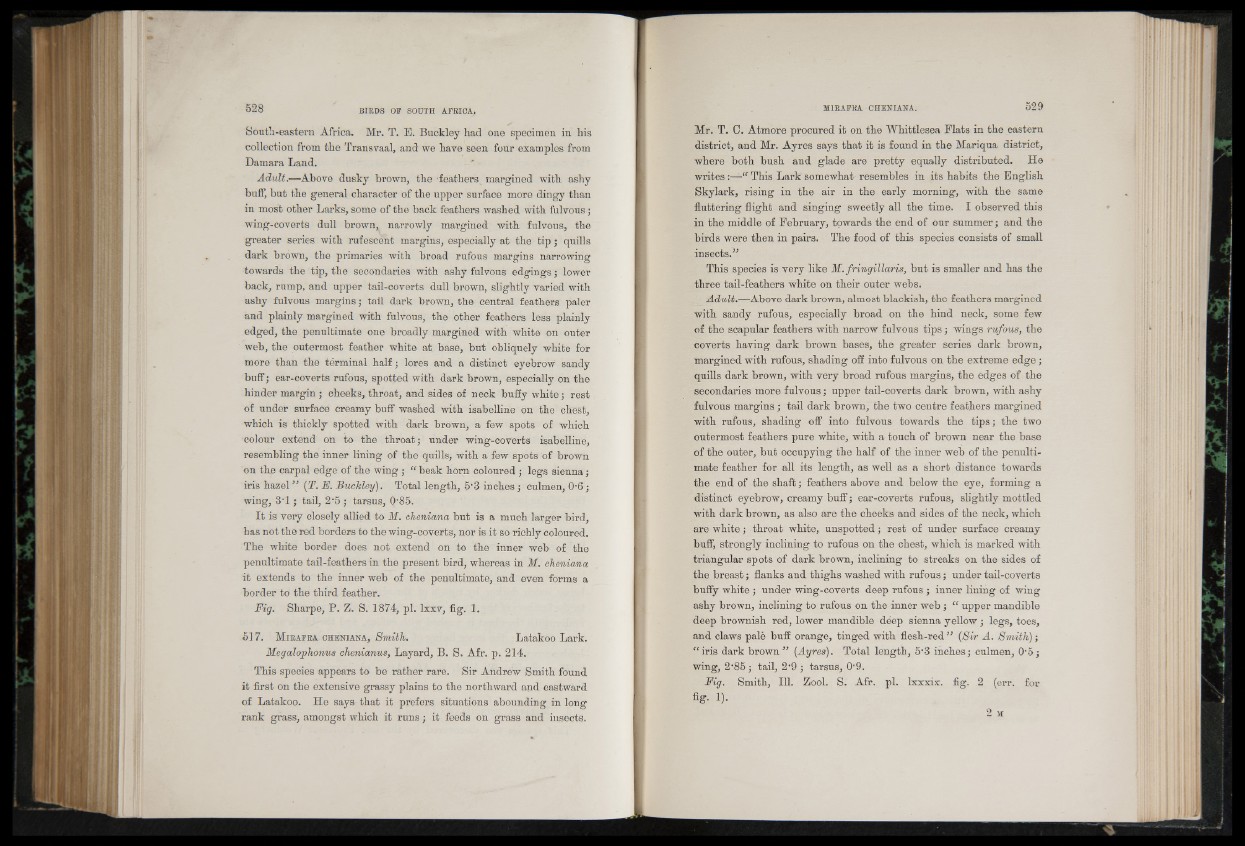
South-eastern Africa. Mr. T. B. Buckley had one specimen in his
collection from the Transvaal, and we have seen four examples from
Damara Land.
Adult.—Above dusky brown, the feathers margined with ashy
buff, but the general character of the upper surface more dingy than
in most other Larks, some of the back feathers washed with fulvous ;
wing-coverts dull brown, narrowly margined with fulvous, the
greater series with rufescent margins, especially at the tip ; quills
dark brown, the primaries with broad rufous margins narrowing
towards the tip, the secondaries with ashy fulvous edgings ; lower
back, rump, and upper tail-coverts dull brown, slightly varied with
ashy fulvous margins ; tail dark brown, the central feathers paler
and plainly margined with fulvous, the other feathers less plainly
edged, the penultimate one broadly margined with white on outer
web, the outermost feather white at base, but obliquely white for
more than the tèrminal half ; lores and a distinct eyebrow" sandy
buff ; ear-coverts rufous, spotted with dark brown, especially on the
hinder margin ; cheeks, throat, and sides of neck buffy white ; rest
of under surface creamy buff washed with isabelline on the chest,
which is thickly spotted with dark brown, a few spots of which
colour extend on to the throat; under wing-coverts isabelline,
resembling the inner lining of the quills, with a few spots of brown
on the carpal edge of the wing ; “ beak horn coloured ; legs sienna ;
iris hazel” (T. F. Buckley). Total length, 5'3 inches ; culmen, 0'6 ;
wing, 3"1 ; tail, 2'5 ; tarsus, Q-85.
It is very closely allied to M. cheniana but is a much larger bird,
has not the red borders to the wing-coverts, nor is it so richly coloured.
The white border does not extend on to the inner web of the
penultimate tail-feathers in the present bird, whereas in M. cheniana
it extends to the inner web of the penultimate, and even forms a
border to the third feather.
Fig. Sharpe, P. Z. S. 1874, pi. Ixxv, fig. 1.
517. M ir a fr a cheniana, Smith. Latakoo Lark.
Megalophonus chenianus, Layard, B. S. Afr. p. 214.
This species appears to be rather rare. Sir Andrew Smith found
it first on the extensive grassy plains to the northward and eastward
of Latakoo. He says that it prefers situations abounding in long
rank grass, amongst which it runs ; it feeds on grass and insects.
Mr. T. 0. Atmore procured it on the Whittlesea Flats in the eastern
district, and Mr. Ayres says that it is found in the Mariqua district,
where both bush and glade are pretty equally distributed. He
writes :—“ This Lark somewhat resembles in its habits the English
Skylark, rising in the air in the early morning, with the same
fluttering flight and singing sweetly all the time. I observed this
in the middle of February, towards the end of our summer; and the
birds were then in pairs. The food of this species consists of small
insects.”
This species is very like M. fringillaris, but is smaller and has the
three tail-feathers white on their outer webs.
Adult.—Above dark brown, almost blackish, the feathers margined
with sandy rufous, especially broad on the hind neck, some few
of the scapular feathers with narrow fulvous tips; wings rufous, the
coverts having dark brown bases, the greater series dark brown,
margined with rufous, shading off into fulvous on the extreme edge;
quills dark brown, with very broad rufous margins, the edges of the
secondaries more fulvous; upper tail-coverts dark brown, with ashy
fulvous margins ; tail dark brown, the two centre feathers margined
with rufous, shading off into fulvous towards the tips; the two
outermost feathers pure white, with a touch of brown near the base
of the outer, but occupying the half of the inner web of the penultimate
feather for all its length, as well as a short distance towards
the end of the shaft; feathers above and below the eye, forming a
distinct eyebrow, creamy buff; ear-coverts rufous, slightly mottled
with dark brown, as also are the cheeks and sides of the neck, which
are white; throat white, unspotted; rest of under surface creamy
buff, strongly inclining to rufous on the chest, which is marked with
triangular spots of dark brown, inclining to streaks on the sides of
the breast; flanks and thighs washed with rufous; under tail-coverts
buffy white ; under wing-coverts deep rufous ; inner lining of wing
ashy brown, inclining to rufous on the inner web ; “ upper mandible
deep brownish red, lower mandible deep sienna yellow; legs, toes,
and claws pale buff orange, tinged with flesh-red ” (Sir A. Smith);
“ iris dark brown” {Ayres). Total length, 5‘3 inches; culmen, 0'5;
wing, 2-85; tail, 2'9 ; tarsus, 0'9.
Fig. Smith, 111. Zool. S. Afr. pi. lxxxix. fig. 2 (err. for
fig. 1).
2 M